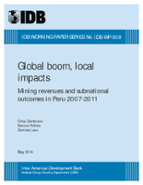Global boom, local impacts: Mining revenues and subnational outcomes in Peru 2007-2011
Date
May 2014
The relationship between the abundance of natural resources and socio-economic performance has been a main object of study in the economic development field since Adam Smith. Dominated by the verification of the so called curse of natural resource, the mainstream literature on the topic has been mostly on the study of cross sectional data at the national level, with limited empirical use of exogenous differences in the abundance of natural resources at the subnational level. We explore the case of Peru, a mining-rich middle income country where -exploiting a unique data set constructed for this purpose- we are able to assess systematic differences in district-level welfare outcomes between mining and non-mining districts. We find evidence that the condition of being mining-abundant district have a significant impact on the pace of reduction of poverty rates and inequality levels. We also estimate a heterogeneous response to the mining-abundant condition, finding stronger responses in lower-poverty, higher-inequality districts. Finally, we find a trend suggesting incremental positive marginal effects of the level of exposure to mining transfer, as proxy for the degree of abundance of mining activities, on the reduction of poverty and inequality.



